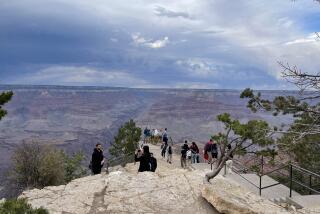Workers Plugging Away on Subway : Transit: Readying the Red Line to open Jan. 30 is complicated by rainwater leaks. The problems persist despite costly efforts during construction that were supposed to prevent gas and water from intruding.
Fighting heavy rainfall and construction imperfections, transit workers are racing to plug dozens of old and new water leaks before Los Angelesâ first subway opens in two weeks.
An inventory prepared by the Los Angeles County Transportation Commission shows that crews are working to plug 56 leaks in the systemâs six stations--with the most extensive problems at Union Station.
âThis is something that is ongoing in all subway systems around the world,â said Stephanie Brady, a commission spokeswoman. âWeâve got a real good handle on it.â
Questions remain about why the leaks have continued, who is responsible and who will continue to pay to plug them. But with a 4.4-mile portion of the Red Line subway scheduled to open Jan. 30, officials are rushing to make the stations dry and to allay concerns of potential patrons.
At Union Station, workers have covered the passenger loading areas while they inject a water-absorbing grout into drip spots. The $120-a-gallon grout expands and hardens, plugging the leaks.
Because much of the subway system courses through areas with naturally occurring methane gases, the system was built with leak prevention in mind. At a cost of about $2 million per mile, the roofs of the subway tunnels and stations were lined with a 1/8-inch-thick polyurethane membrane. The membrane is supposed to prevent gas and water from intruding.
For two years, however, water leaks have developed. A recent tour of the stations and tunnels found that new leaks have emerged during the past week.
The leaks have caused much finger-pointing and cost millions of dollars. In some instances, contractors have won extra payments to attempt repairs on tunnels and stations. In other cases, the transportation commission seeks to charge contractors for repairs.
âHere we are, spending $2 million a mile (in upfront construction cost) to keep the gas out--and the waterâs coming in. That is absolute nonsense,â said James Pott, an engineer who resigned last spring as a member of the commissionâs subsidiary board, the Rail Construction Corp.
Pott and other professionals said that even though the membrane is leaking there is no danger of gas accumulating because the system is ventilated by what amounts to a massive air-conditioning system.
Engineers familiar with the subway system also agree that the water leaks do not represent a threat to the structural soundness of walls or roofs. Yet the leaks do pose a potential slip-and-fall safety hazard, and an image problem.
Brady, the commission spokeswoman, said passengers need not worry about a few leaks in the stations.
The commission is paying one contractor, Morrison Knudsen, about $2.5 million to grout and patch leaks at each of the six stations scheduled to open this month. Contractors and workers who have helped build the Red Line say the leaks can be attributed in part to improper installation of the 1/8-inch-thick membrane.
To function properly, the seams of the membrane--resembling wrap for a massive sandwich--must be welded with torches. Workers also must avoid driving nails into the membrane or stepping on it before installation.
As the leaks attest, handling and installing the membrane proved to be tricky.
âThink about trying to take rolls and rolls of membrane and stretching it around hundreds of thousands of square feet of tunnel,â said Lonnie Lunsford, a Sacramento-area subcontractor whose company is working at Union Station. âThe membrane is like a Baggy: if you stick a needle through it, it will leak. Or (it will leak) if you donât weld the seams well.â
Although transportation commission officials note that all subways leak, the problems with the first 4.4-mile segment have prompted more extensive prevention measures for the next Red Line segment.
That segment, heading west from MacArthur Park, is being built with extra membrane on the roofs and walls of stations and tunnels. The new construction rules also require that âinstallation crews and inspectors will be manufacturer-certified for installation procedures and technique.â
Times staff writer Claire Spiegel also contributed to this story.
More to Read
Sign up for Essential California
The most important California stories and recommendations in your inbox every morning.
You may occasionally receive promotional content from the Los Angeles Times.











